SPECIES COMPOSITION AND DISTRIBUTION OF ACROPORA CORALS IN NHA TRANG BAY AND ADJACENT WATERS
Coastal Branch of Joint Vietnam-Russia Tropical Science and Technology Research Centre
30 Nguyen Thien Thuat, Nha Trang, Khanh Hoa, Vietnam
Số điện thoại: 0986019997; Email: mrtran_cnvb@yahoo.com
Nội dung chính của bài viết
Tóm tắt (Abstract)
Nha Trang Bay (Khanh Hoa, Vietnam) is widely recognized for its rich and diverse coral reef ecosystems, where Acropora corals play a foundational role in reef construction and ecological function. Nevertheless, these ecosystems are increasingly threatened by the combined effects of climate change and human-induced disturbances. This study shows the species composition and distribution of the coral genus Acropora in Nha Trang Bay and adjacent waters. A total of 10 sites were surveyed using SCUBA-based Reef Check methodology, focusing on coral identification through morphological and skeletal characteristics. The 29 species of Acropora recorded with significant species richness found at Hon Bac Island, Hon Chong–Dang Tat, and Dam Bay sites. However, degradation of the coral reef is also recorded at multiple sites, with Acropora species experiencing dramatic declines due to the global coral bleaching event of 2024. Despite these pressures, some areas like Dam Bay show potential for coral restoration. Among the surveyed sites, Hon Bac Island and the nearshore waters north of Hon Chong stand out as ecologically valuable areas due to their exceptional live coral cover and biodiversity. In particular, Dam Bay, a designated coral gene pool preservation site - plays a vital role in ongoing conservation efforts. In addition to providing baseline ecological data, the study offers key recommendations for conserving and restoring Acropora reefs in Nha Trang Bay, including the establishment of marine protected zones in biodiversity hotspots, implementation of targeted coral restoration programs, enhancement of long-term monitoring and early-warning systems, and promotion of science-based, community-supported conservation strategies in areas showing signs of natural recovery. The findings provide crucial baseline data for conservation planning, restoration strategies, and genetic resource preservation of Acropora in Southern Vietnam.
Từ khóa (Keywords)
Acropora, coral reef, composition, distribution, Nha Trang bay
Chi tiết bài viết
- Highlights:
Twenty-nine Acropora species were recorded, with high diversity at key sites like Hon Bac, Hon Chong–Dang Tat, and Dam Bay.
The study provides essential baseline data for the conservation and restoration of Acropora in Southern Vietnam.
1. INTRODUCTION
Nha Trang Bay, located in Khanh Hoa province, Vietnam, is distinguished by its coral reefs and marine biodiversity. Among the diverse coral genera, Acropora are particularly significant due to their role in reef-building and ecosystem support. However, like many coral reefs worldwide, Nha Trang Bay faces threats from climate change, pollution, and human activities. This paper examines the current status of Acropora coral distribution in Nha Trang Bay and its surrounding waters, , challenges, and conservation efforts.
The study of Latypov Y.Y. on coral reef ecosystems in Nha Trang Bay and Van Phong Bay recorded 39 species belonging to the genus Acropora [1]. The number of Acropora species in Nha Trang Bay has been recorded in various studies, but these numbers can be different depending on the scope of the research and the time of the survey. According to recent studies and reports, Nha Trang Bay is home to a significant diversity of Acropora species, estimated about 15 to 20 species. These include well-known species such as Acropora millepora, A. hyacinthus, A. nasuta, and A. muricata (A. formosa), among others [1, 2].
However, Konstantin Tkachenko in recent research reveals some worrying facts about coral reef degradation, the average coral cover has decreased by 64.4%, of which the Acropora and Montipora have decreased by 80.6% and 82.3%, respectively. The total area of rich and healthy coral reefs in Nha Trang Bay has decreased from 6.65 km² before the 1980s to 0.74 km² in 2019, equivalent to a loss of 90% in less than 40 years [3, 4]. The coral reefs in Southern Vietnam, particularly in the Con Dao Islands (previously recognized for their high coral cover and biodiversity) were severely affected by the fourth global coral bleaching event in 2024. Surveys conducted in June and October 2024 using cross-sectional photo-transect methods revealed the most extensive coral bleaching and mortality ever recorded in the region. The results indicate that the bleaching occurred throughout the entire vertical distribution of reef-building corals. These findings demonstrate that: the 2024 global bleaching event had a profound impact on coral reef ecosystems in southern Vietnam [5]. The study by Konstantin Tkachenko also confirmed that the coral bleaching threshold defined by NOAA/CRW for Southern Vietnam is 30 °C [5]. During the period of June to July 2024, scientists from the Vietnam-Russia Tropical Center also recorded coral bleaching in Hon Chong and Hon Bac (unpublished data). Therefore, the current species composition and distribution of corals in Nha Trang Bay may change, especially the coral species of the genus Acropora. This paper will provide information on the current distribution of hard corals of the genus Acropora in Nha Trang Bay to serve the conservation, protection, and restoration of this important coral species.
2. MATERIAL AND METHODS
This study focused on corals belonging to the genus Acropora. Field surveys were conducted from July to October 2024 at ten sites: Hon Bac (station 1), Bai Tien (station 2), Dang Tat (station 3), Hon Chong (station 4), Hon Tam (station 5), Hon Mot (station 6), Dam Bay 1 (station 7), Dam Bay 2 (station 8), Bich Dam (station 9), and Bich Dam 2 (station 10) (Fig. 1).

Figure 1. The map of observed sites (red dots)
Observed Method: Coral reef samples were collected using SCUBA diving, with transects adapted from the Reef Check method serving as a framework for sample collection [6]. At each site, Acropora was specifically observed. Underwater photographs were taken using a Panasonic Lumix G80 in an Ikelite underwater housing. Photos with wide-angle, close-up, and macro shots were used to assist in species identification.
Method of identification: Species of the genus Acropora were identified based on a combination of morphological characteristics, live coloration, and skeletal structures. Field identification of Acropora corals was based on key morphological characteristics, including colony growth forms, corallite structures, and pigmentation patterns, following established identification guides [7, 8]. In cases where field identification was not possible, such as when morphological traits were too similar between species or when specimens were damaged, representative samples were collected for further analysis in the laboratory. Laboratory procedures included high-resolution photography and comparisons with reference skeletal materials to confirm identification at the genus and species levels. This combined approach is widely accepted as a reliable method for accurate identification of Acropora species in ecological research and monitoring programs [1, 7–9].
3. RESULTS AND DISCUSSIONS
Nha Trang Bay is renowned for its rich coral reef ecosystems, with a hight diversity of species from the genus Acropora - one of the most important and widespread genera of reef-building corals. Here is a list of Acropora species that have been identified in Nha Trang Bay, with citations to relevant studies where available. Below is a list of Acropora species documented in Nha Trang Bay, along with references to relevant publications where available.
Among the ten observed coral reef sites, two ecologically important locations - Hon Bac Island and the nearshore waters north of Hon Chong (in Nha Trang Bay) are focussed on, due to their notably high live coral cover and species richness. In addition, special attention is given to the Dam Bay - coral gene pool preservation area -, which plays a vital role in conservation efforts. The findings from these key locations are presented below:
3.1. Hon Bac Island
Hon Bac, a small offshore island in Nha Trang Bay, is characterized by its high coral diversity. Although its limited size, the coral concentrated on the sea surface west of Hon Bac at a depth of 4 - 6 m. Twenty species of Acropora in the reef areas surrounding the island were recorded, making it one of the most diverse Acropora habitats in the region (Table 1). The dominant species include A. yongei, A. muricata, A. cytherea.
The reef structure here is well, with a variety of colony forms including table, branching, and corymbose morphologies. The relatively undisturbed location, clear waters, and suitable substrate provide good conditions for Acropora growth and regeneration. This site plays an important role as a genetic reservoir for Acropora corals in Nha Trang Bay and adjacent waters.
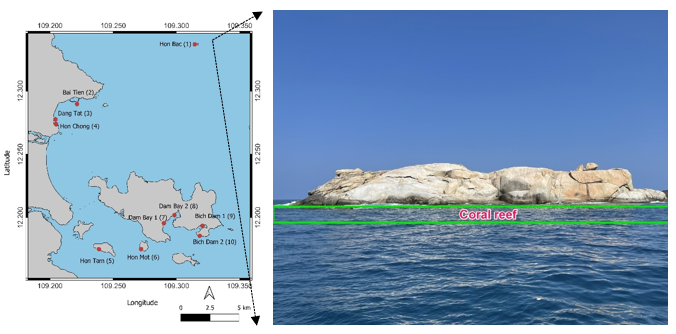
Figure 2. Hon Bac Island is located in the north of Nha Trang Bay.
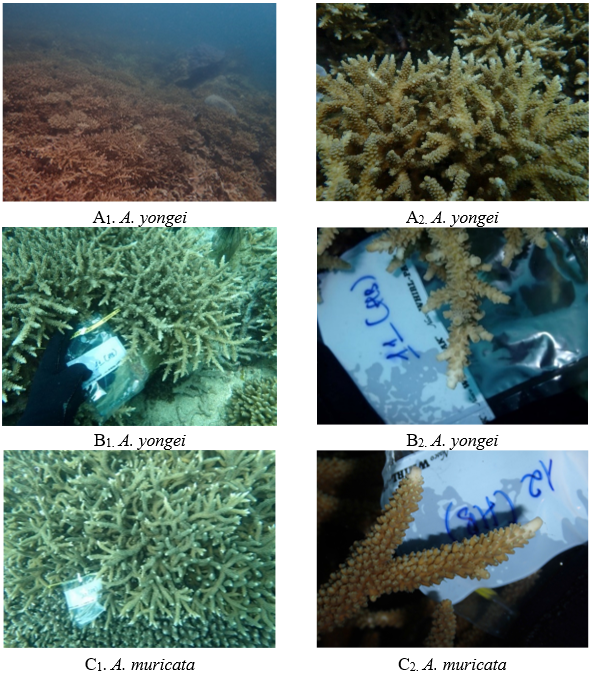
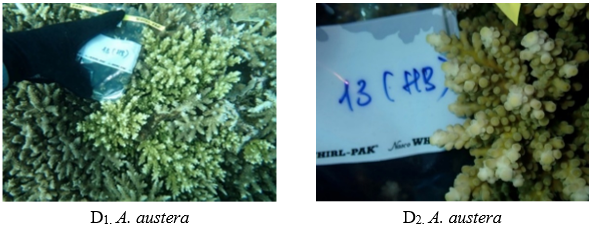
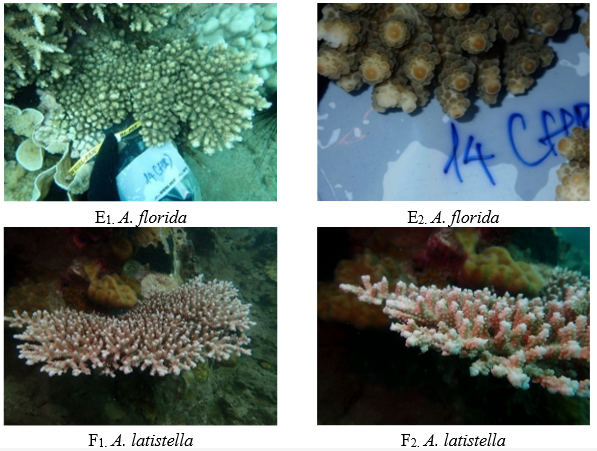
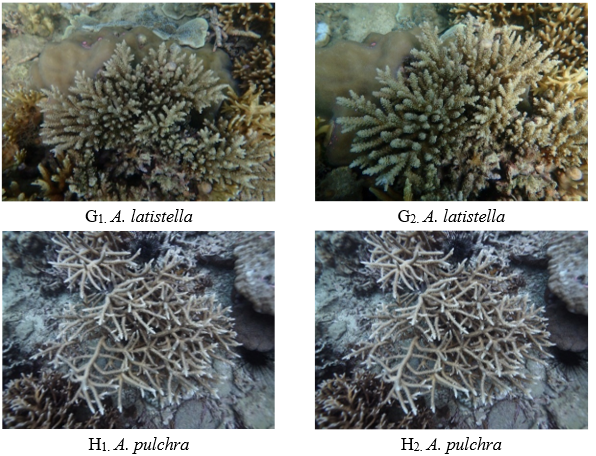

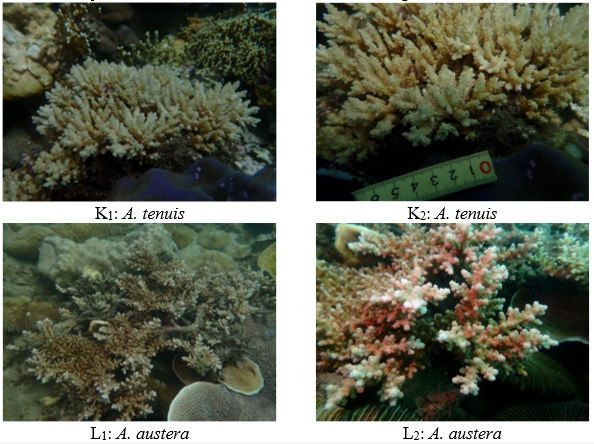
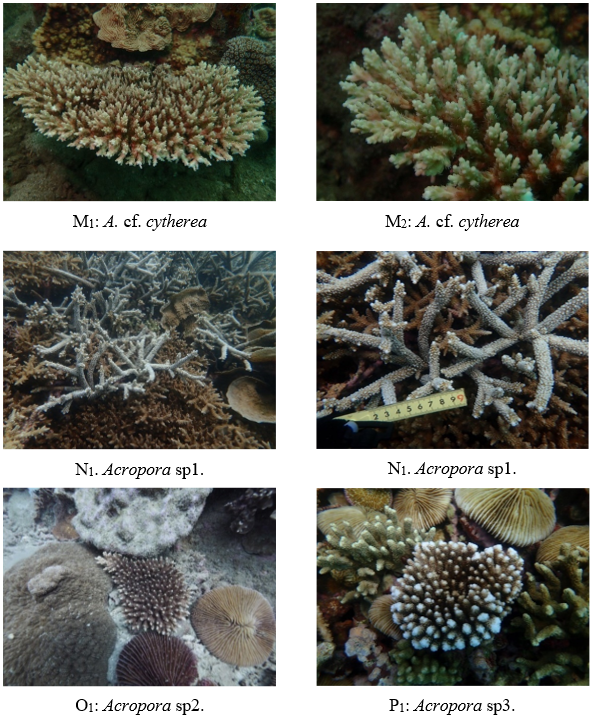
Figure 3. Some species of the Acropora recorded in Hon Bac Island
Therefore, the coral reef at Hon Bac Island serves as an important source of Acropora coral genetic material for the Nha Trang Bay around the area. As well as the Hon Chong – Dang Tat reef system, the Hon Bac reef requires strict management. However, the site continues to face significant threats from boat anchoring activities (Fig. 4), marine debris, and discarded fishing nets,... Additionally, this reef has also experienced signs of coral bleaching during the widespread bleaching event in 2024, further emphasizing its vulnerability (Fig.5). It is strongly recommended that clear demarcation of the reef protection zone be implemented, alongside awareness campaigns targeting local communities to enhance conservation efforts for this ecologically important coral reef.
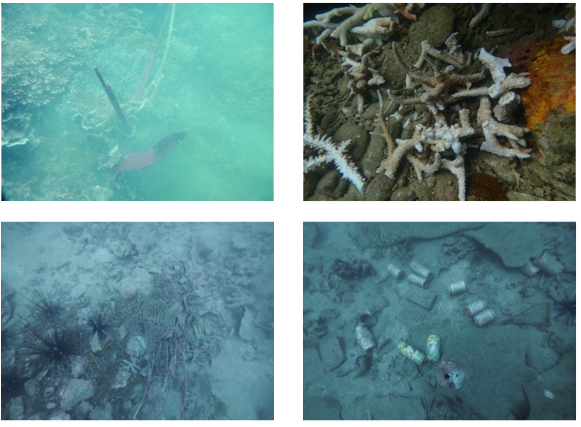
Figure 4. Impacts from humans to the coral reef in Hon Bac Island
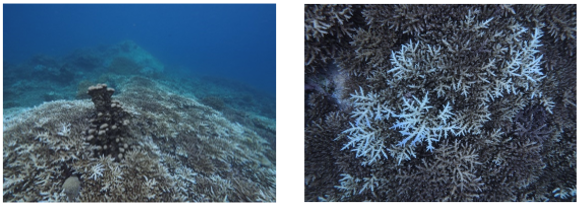
Figure 5. Coral bleaching phenomenon in Hon Bac Island in 2024 (June-July)
3.2. Hon Chong – Dang Tat
Despite being located in nearshore waters with increasing anthropogenic pressures, the coral reefs at Hon Chong – Dang Tat in Nha Trang still maintain a remarkable distribution of Acropora species. Field observations recorded the presence of 16 distinct Acropora species, highlighting the ecological significance and resilience of this reef system. Notable species include A. hyacinthus, A. robusta, A. aspera, and A. muricata (Fig. 6), which are recognized for their significant contributions to reef building and habitat complexity. The persistence of such biodiversity in a nearshore area underscores the urgent need for focused conservation strategies to protect this valuable reef from future degradation.
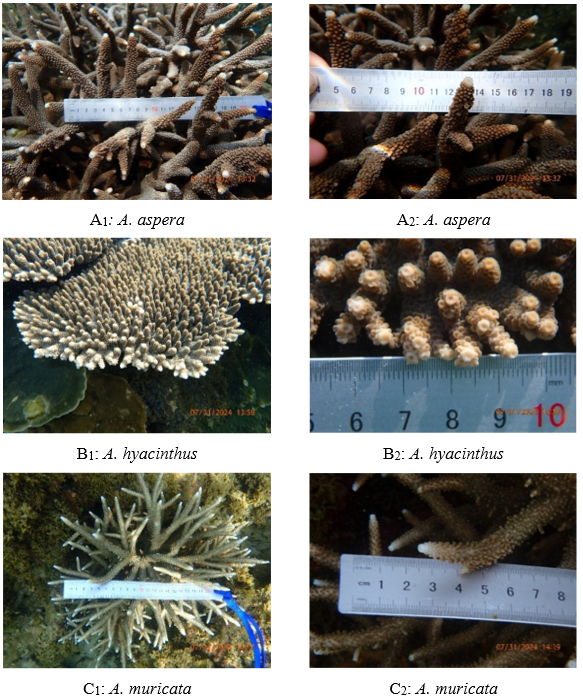
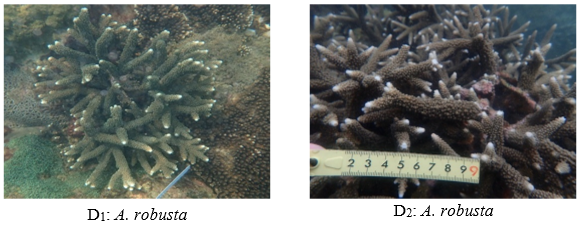
Figure 6. The most common coral species distributed in the Hon Chong - Dang Tat area
3.3. Dam Bay
The Dam Bay marine area is home to a diverse assemblage of Acropora coral species. As of the most recent survey, 10 species of Acropora have been recorded in this region, with A. muricata and A. latistella being among the most commonly observed (Fig. 7). In addition to supporting natural coral populations, Dam Bay also serves as a designated site for coral conservation and scientific research. The area is managed by the Coastal Branch of the Joint Vietnam-Russia Tropical Science and Technology Research Center.
The waters around Dam Bay station are relatively shallow, with an average depth of 4.1 meters, ranging from 1.3 to 7.6 meters. These conditions—moderate depth, calm water, and good light penetration—are ideal for coral growth and reproduction. During field surveys, colonies of Acropora digitifera and Acropora muricata were observed growing on rocky surfaces and the skeletons of dead corals within the station’s protected area. This suggests that natural coral recruitment and regeneration are actively taking place (Figs. 8 and 9). The combination of favorable environmental conditions and active conservation efforts makes Dam Bay an important site for Acropora biodiversity and coral reef restoration in Nha Trang Bay.
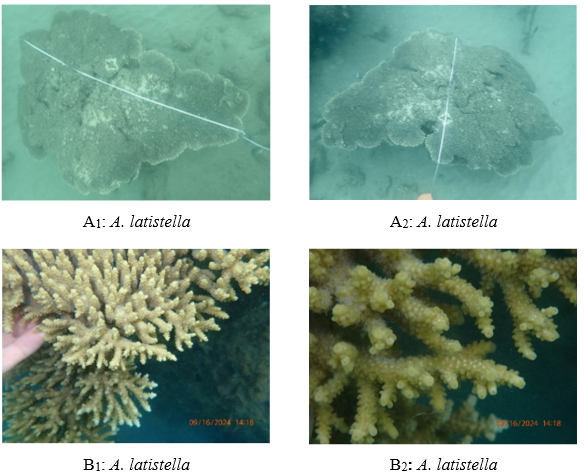
Figure 7. The coral species A. latistella has been preserved for over 15 years (since 2009; 265 cm in length, 188 cm in width) at Dam Bay station
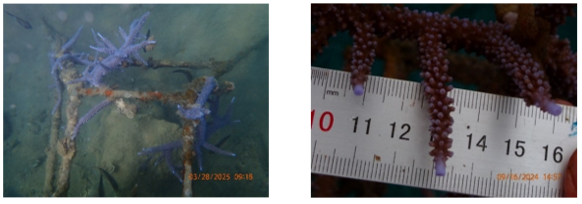
Figure 8. The purple coral species A.muricata. recorded at Dam Bay site
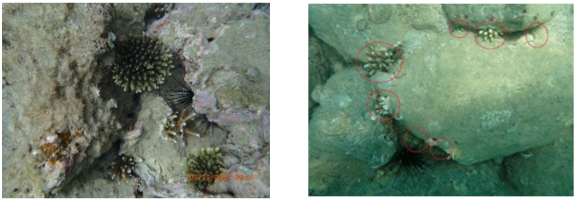
Figure 9. Naturally occurring juvenile Acropora spp. populations in the waters of Dam Bay site
3.4. Bai Tien
Bai Tien, located on the northern coast of Nha Trang, was once home to diverse and colorful coral reef ecosystems, especially rich in Acropora species. Historically, this nearshore area supported dense coral cover and high species diversity, contributing significantly to the ecological health of the region.
However, in recent years, extensive coastal development - including land reclamation, dredging, and increased sedimentation - has led to a dramatic decline in coral coverage. These activities have degraded water quality, increased turbidity, and disrupted the natural conditions required for coral survival. As a result, most of the coral reefs in Bai Tien have been lost.
Currently, only a few scattered colonies remain, primarily of A. digitifera and A. muricata (Fig. 10). Encouragingly, during recent surveys, several small-sized colonies of Acropora species have begun to reappear, suggesting the potential for natural recovery. Their presence indicates that despite severe disturbances, coral larvae are still settling and surviving under the right micro-habitat conditions.
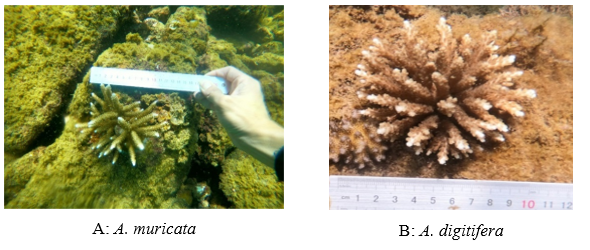
Figure 10. Two Acropora species of coral in the Bai Tien site
3.5. Mot and Tam Islands
Although Hon Mot and Hon Tam Islands are located farther offshore compared to coastal areas like Bai Tien, their coral reefs are also facing serious degradation. These offshore sites were once known for their extensive and healthy coral communities, including diverse Acropora species forming branching thickets and plate-like structures.
However, ongoing pressures from unregulated coastal development, increased marine traffic, and unsustainable fishing practices, such as anchor damage, destructive fishing gear, and over-harvesting, have severely impacted the reef ecosystems around these islands. Sediment runoff from nearby developments and increased nutrient input have contributed to water quality decline, while physical breakage and reef trampling continue to damage fragile coral structures.
Recent assessments show a sharp reduction in live coral cover, particularly among sensitive genera such as Acropora. Only sparse and isolated colonies of A. hyacinthus, A. monticulosa, and A. digitifera remain, often in suboptimal conditions and with signs of bleaching or partial mortality. The loss of structural complexity has also affected reef-associated species that depend on Acropora habitats.
3.6. Bich Dam Island
Bich Dam is a small coastal village in Nha Trang, characterized by a dense population primarily engaged in traditional fishing activities. In recent years, a modest tourism sector has also emerged. According to previous surveys and literature, the coral reefs around Bich Dam once exhibited high live coral cover and remarkable species diversity.
However, due to the proximity to the residential area and the pressures from human activities, such as fishing, pollution, and domestic waste discharge, the coral ecosystem here has undergone severe degradation. Presently, only scattered and isolated coral colonies remain, most of which are small in size. The dominant coral genera observed include Favia, Favites, and Porites, which are generally more tolerant of environmental stressors.
As for Acropora, only two species were recorded at the Bich Dam 1 site (A. muricata, A. sp.), represented by a few small and vulnerable colonies. These Acropora fragments are also showing signs of bleaching, and the area is heavily affected by algal overgrowth, indicating poor water quality and declining reef health.
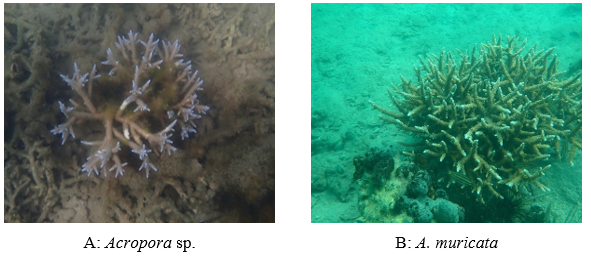
Figure 11. Two species of coral in Bich Dam sites
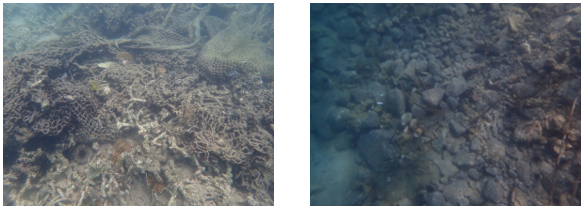
Figure 12. Current status of bottom pollution at Bich Dam sites
4. CONCLUSIONS AND RECOMMENDATIONS
The current study reveals that Nha Trang Bay has experienced a severe decline in Acropora coral cover and species diversity in recent decades despite being recognized as one of the richest coral reef ecosystems in Vietnam. While records documented up to 39 species of Acropora in Nha Trang Bay specifically, the latest surveys conducted from July to October 2024 recorded only 29 species, indicating a significant reduction in species composition and spatial distribution.
Among the 10 observed sites, only Hon Bac Island maintained relatively high Acropora diversity and coverage, with 20 species observed, such as A. yongei, A. intermedia, and A. muricata. Other sites, including Dam Bay and Hon Chong – Dang Tat, still support 14–16 species, with some signs of natural regeneration and conservation management. In contrast, locations like Bich Dam and Bai Tien, once known for their rich coral cover, now host only 1–2 Acropora species in small and fragmented colonies, often under stress from bleaching, algae overgrowth, and coastal development.
The study also emphasizes the devastating impact of the 2024 global coral bleaching event, which has further accelerated the degradation of Acropora habitats throughout the bay. The reduction in both live coral cover and habitat complexity poses a critical threat to associated reef biodiversity and ecosystem services.
To mitigate the ongoing decline and promote the recovery of Acropora coral populations in Nha Trang Bay, the following integrated conservation and restoration measures are recommended:
Establish and enforce marine protected zones (MPZs), especially in biodiversity hot spots such as Hon Bac, Dam Bay, and Hon Chong – Dang Tat, where Acropora species are still relatively abundant. These zones should restrict anchoring, destructive fishing, and tourism activities.
Implement coral restoration programs using micro-fragmentation techniques and coral nurseries for Acropora species, especially A. muricata, A. hyacinthus, and A. robusta. Both in-situ and ex-situ propagation should be combined with scientific monitoring.
Enhance environmental education and outreach targeting local communities and tourism operators to raise awareness about the ecological value of Acropora reefs and promote sustainable practices.
Control land-based pollution and sedimentation, especially in nearshore areas like Bich Dam and Bai Tien, through improved wastewater treatment, fisheries regulation, and coastal development planning.
Monitor coral health and bleaching events regularly, especially during periods of thermal stress. The use of early-warning systems and rapid response actions (e.g., shading, cooling measures in nurseries) should be explored.
Support scientific research and data-sharing to understand species resilience and guide future conservation strategies, including genetic diversity assessments of local Acropora populations.
By combining policy enforcement, restoration technology, local engagement, and scientific support, it is possible to halt the decline and restore the ecological function of Acropora coral reefs in Nha Trang Bay, ensuring the long-term sustainability of marine biodiversity and livelihoods.
The genus Acropora in Nha Trang Bay is currently highly vulnerable. Conservation actions such as zoning, reef protection, and active restoration programs, particularly focused on Acropora-rich areas like Hon Bac, Hon Chong – Dang Tat, and Dam Bay, are urgently needed. Long-term monitoring and community engagement are essential to prevent further losses and to support the recovery of these ecologically significant coral reefs.
Table 1: Composition and distribution of coral genus Acropora
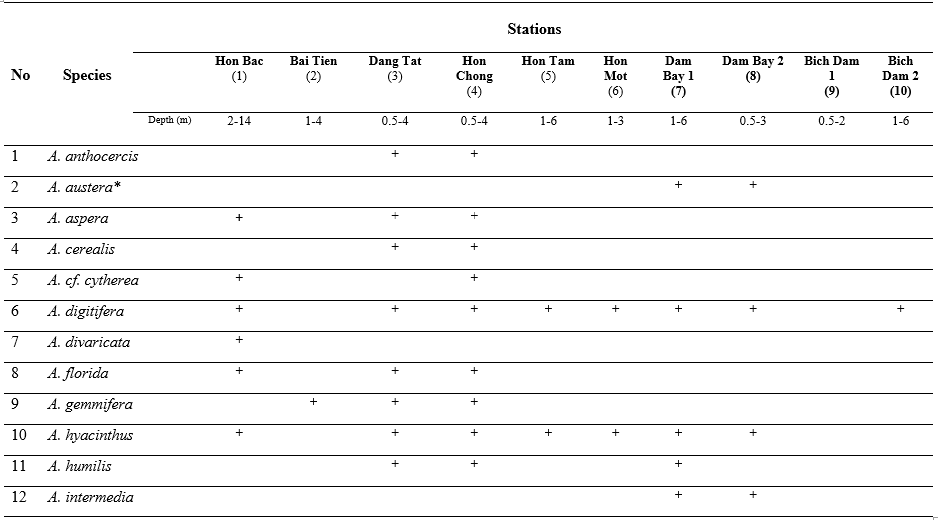
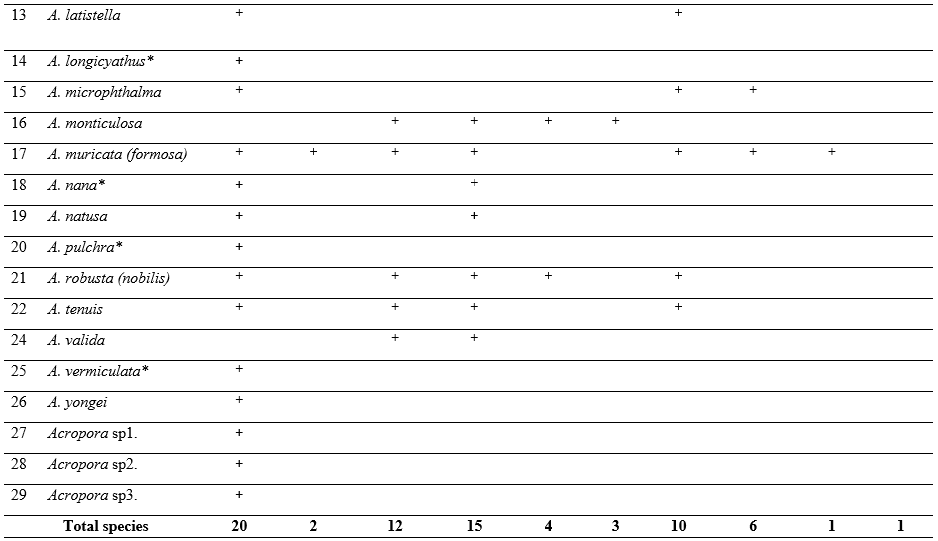
Note: “+” represents species at the study site; “*” - new record compare to Latypov, Y.Y. 2011
Acknowledgments: Funding for implementation is provided by the Gene Conservation mission: Preserving and conserving the genetic resources of some coral species of the genus Acropora in the Dam Bay marine station, Nha Trang Bay (Decision no. 3268/QĐ-TTNĐVN on 13th August, 2024). We would like to thank Professor Konstantin S. Tkachenko for his active contribution to the article.
Author Contributions: Dien, Samoilov conceived and designed the study. Dien, Samoilov conducted field surveys and data collection. Dien, Hieu, Dung and Bang carried out data analysis. Dien, Viet and Anh were responsible for coral species identification and morphological verification. Lien, Ha coordinated field logistics and ensured data quality control. Dien supervised the research, secured funding, and revised the final manuscript for publication.
Conflict of Interest statement: The authors declare that there is no conflict of interest.
Tài liệu tham khảo
2. S.T. Vo, and G. Hodgson, Coral reefs of Vietnam: Current status and conservation strategies, Proceedings of the 8th International Coral Reef Symposium, Panama, 1997
3. K.S. Tkachenko, N.H. Huan, N.H. Thanh and T.A. Britayev, Extensive coral reef decline in Nha Trang Bay, Vietnam: Acanthaster planci outbreak: the final event in a sequence of chronic disturbances. Mar. Freshw, Res. 72:186–199, 2020. https://doi.org/10.1071/MF20005
4. K.S. Tkachenko, Coral reefs degradation under complex impact of natural and anthropogenic factors with Nha Trang Bay (Vietnam) as an example, Biol. Bull. Rev, 13(5):442-459, 2023. https://doi.org/10.1134/S2079086423050079
5. K.S. Tkachenko, V.V. Dung, V.T. Ha and H.H. Phong, Unprecedented coral bleaching in Southern Vietnam in 2024: the only hope for thermal refuges, Coral Reef, 2025. https://doi.org/10.1007/s00338-025-02651-8
6. G. Hodgson, and S. Waddell, International reefcheck core method, University of California at Los Angeles, 1997
7. C.C. Wallace, Staghorn corals of the world: a revision of the coral genus Acropora (Scleractinia; Astrocoeniina; Acroporidae) worldwide, with emphasis on morphology, phylogeny and biogeography, CSIRO publishing, 1999
8. J.E.N. Veron, Corals of the World. Australian Institute of Marine Science, 2000
9. Y.Y. Latypov, Coral Reefs of Vietnam, Moscow: Nauka, 2007 (In Russian)